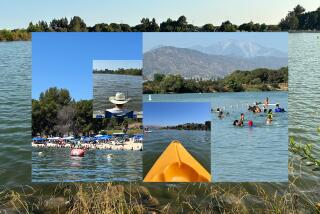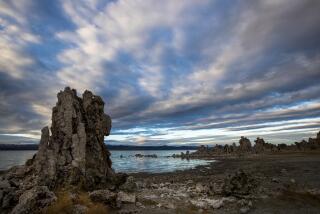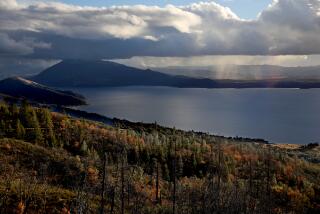Cities’ thirst nearly killed these California lakes. Not so fast, said our epic wet winter
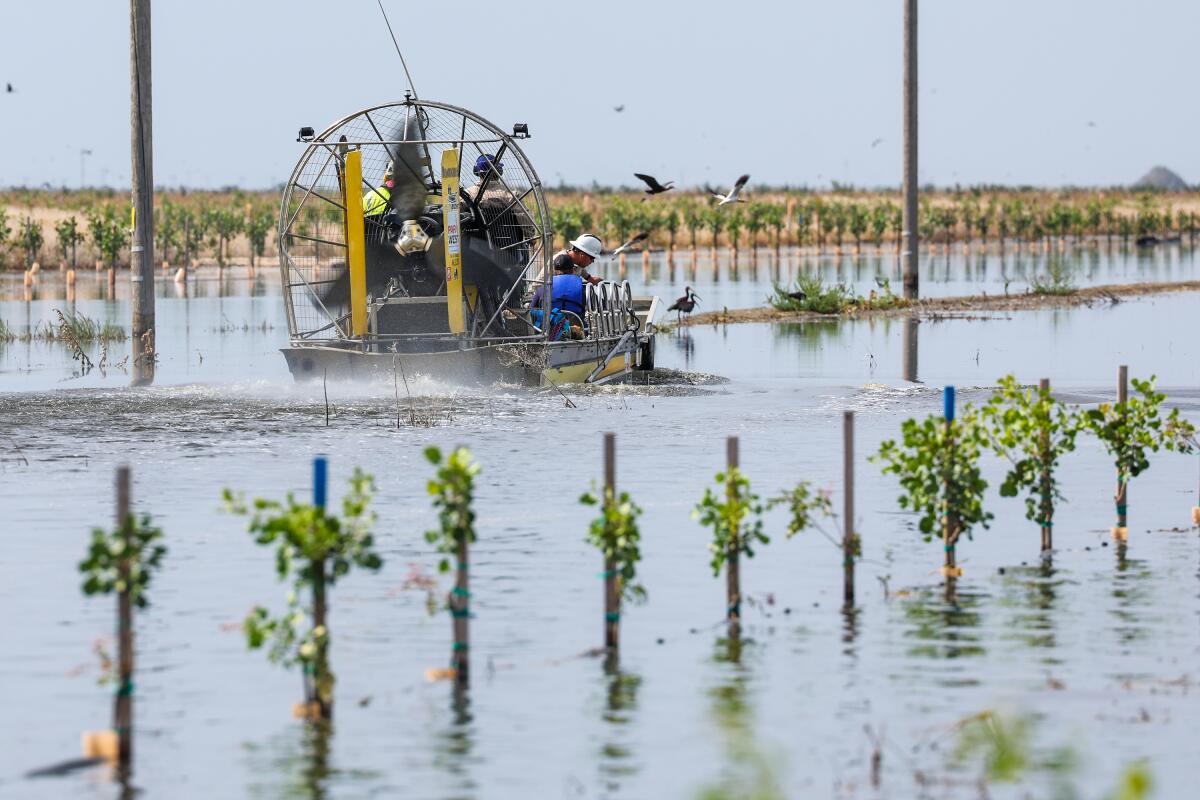
- Share via
They’re back! Arising out of their dusty/muddy/sandy graves, the zombie lakes of California are reclaiming their own.
For geologic ages, they have lain there, undead — well, often drought-dry, and not their original saturated selves. But now the monumental rains of this winter and spring filled them and then some, reminding us of California’s paleo-hydrology, our ancient lakes and waterways.
The Mojave Desert was in eons past a kind of Lake District, with once-splendid bodies of water later named Manly, Searles, Panamint, Tecopa, Manix. The desert city of Blythe, at California’s eastern edge, used to be coastal property along the Gulf of California. The Pacific Ocean reached its shallows far inland from its present coast; a whale vertebra, about a dozen million years old, was turned up five years ago by Metro subway excavators in downtown L.A. Basically, the California of multiple thousands and millions of years ago was a-slosh with glacial leavings, lakes and rivers. And with our epochal rains, some of these old bodies have risen to assert themselves again, which sounds like something out of H.P. Lovecraft.
We’ve come to terms with our seasonal Western rivers as creatures of feast or famine, but seeing the same thing with stupendous rains and likely stupendous runoff in our barely there lakes is more of a novelty.
Tulare Lake, in the San Joaquin Valley, used to be the biggest freshwater lake west of the Mississippi, about 800 square miles, providing the living space and livelihood for hundreds of Native Americans, rising and falling according to mountain snowpack runoff. But around about a hundred years ago, all those waterways were redirected to farms, and the lake bed itself got plowed and cultivated for crops.
Now those crops — cotton, pistachios, tomatoes — and the farms that grow them are imperiled, even ruined.
Get the latest from Patt Morrison
Los Angeles is a complex place. Luckily, there's someone who can provide context, history and culture.
You may occasionally receive promotional content from the Los Angeles Times.
But for Native Americans of the Santa Rosa Rancheria Tachi Yokut Tribe, Pa’ashi, the living lake, has revived, and they rejoice and would like to see it stay that way. Robert Jeff, the tribe’s vice chairman, says: “As Native people, there has been something missing in our spirit. There’s been something missing in our souls. And what you see behind us now is Pa’ashi has reawakened. At the same time, it’s reawakened a lot of spirits.”
Stephanie Pincetl, a professor at the Institute of the Environment and Sustainability at UCLA, told me that she also sees positives to this wetter reality.
“We thought we could overpower nature and reengineer it with no consequences. We are seeing that that is not true over time, and I think the resurgence of these lakes is another example of that. Maybe going forward, we should be a little more respectful and find ways to accommodate, to at least some degree, the coming back of these water bodies, and what they mean, not only spiritually and for subsistence for Native peoples, but that they offer extraordinarily valuable habitat and offer ways to recharge groundwater — a lot of important reasons why they should be allowed to persist.”
Tulare Lake’s Indigenous population “lived beside and fished in this — this is their homeland. No one really remembers how that land was expropriated and levees were built and it was claimed for agriculture, much of it extremely large-scale industrial agriculture.
“That part is really important: What is that land used for? What is the wage structure for the farmworkers? There’s a whole political ecology side of it that needs to be talked about,” she said.
And the spectacular rains and snowpack runoff should be the moment to do so.
“I feel bad for people who have constructed their lives around working for agriculture in this region and where the towns are,” Pincetl added. “But they are also being exploited — the farmworkers and people who are not being given the kind of incomes to live prosperous lives,” and the Native Americans displaced early on.
Farther south, until it disappeared pretty much for good about 500 years ago, Cahuilla Lake had a long footprint from near Palm Springs to below the present U.S.-Mexico border. It too supported generations of Native Americans. (The misbegotten Salton Sea lies within the Cahuilla’s old boundaries.)

Now, as to Mono Lake, deserving of two chapters in Mark Twain’s book of his western adventures, “Roughing It”:
Mono is a million years old, one of North America’s oldest lakes, a sci-fi landscape of calcium carbonate tufa towers, more than twice as salty as the sea itself, and eerie-looking empty or full. After noting the virtues of its alkaline waters for washing clothes, Twain pretty much ran out of good things to say about it.
“This solemn, silent, sailless sea — this lonely tenant of the loneliest spot on earth — is little graced with the picturesque. It is an unpretending expanse of grayish water, about a hundred miles in circumference, with two islands in its centre, mere upheavals of rent and scorched and blistered lava, snowed over with gray banks and drifts of pumice stone and ashes, the winding sheet of the dead volcano, whose vast crater the lake has seized upon and occupied,” he wrote.
It was Twain who famously wrote that in the West, whiskey is for drinking and water is for fighting over. And the waters of Mono Lake, some of which have wet the whistles and the gardens of Los Angeles for decades, are the battle stakes once again, among thirsty water customers, environmentalists, Native Americans. For almost 50 of Mono Lake’s million years, California cars — even in Los Angeles — have borne bumper stickers reading “Save Mono Lake.” The winter and spring storms have brought at least 5 feet of snow and inches of rain, not enough to save Mono forever, but for a glimpse of what a million-year-old lake could be.
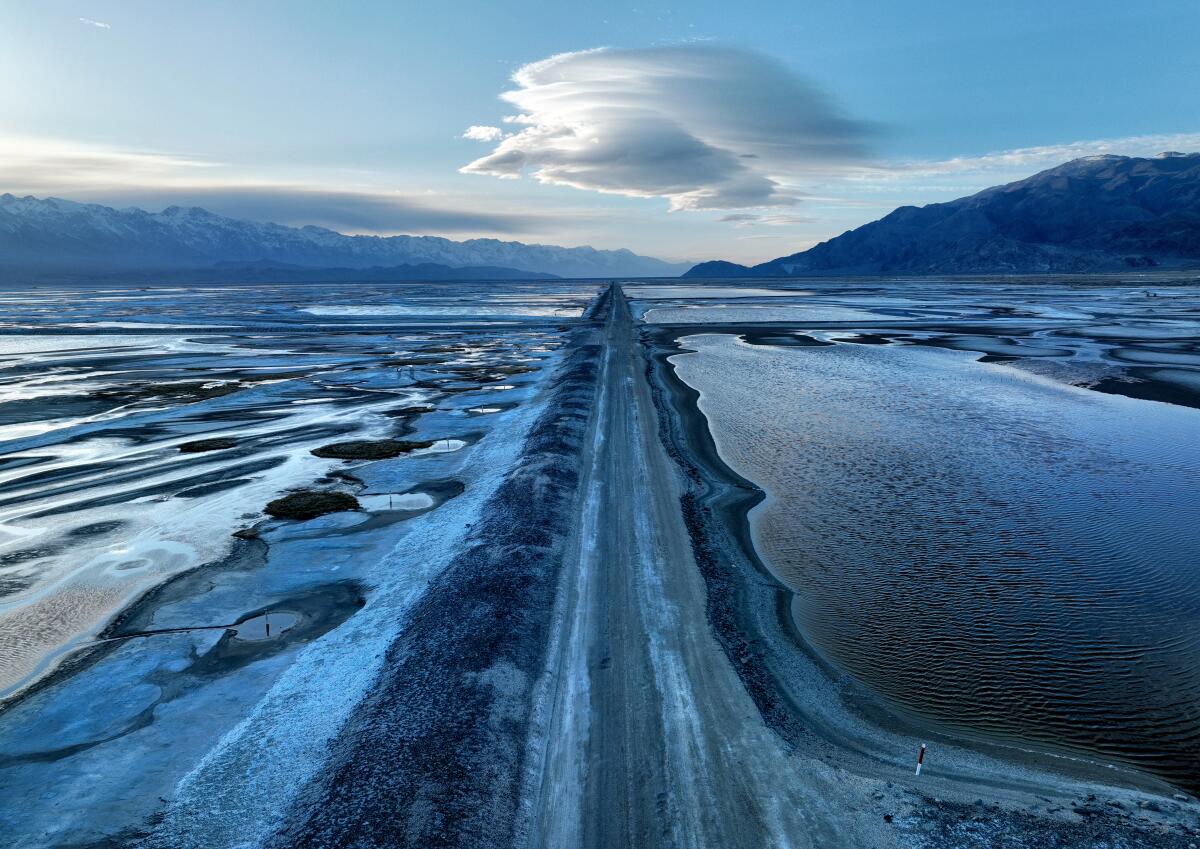
And then there’s Owens Lake, more recently just called Owens dry lake. Los Angeles’ city officials and civic moguls finagled and schemed more than 110 years ago to bring its waters to Los Angeles — essentially sticking a 200-something-mile-long straw in the lake. The city’s been sucking ever since.
It used to be a lively body of water, fringed by farms and, until about 1880, crisscrossed by two little steamboats, Bessie Brady and Molly Stevens, ferrying silver ore from the mine operations up in the mountains.
The March storms that dumped something like a foot of rain in parts of the valley fell so generously upon Owens Lake that a paradox was created: Years ago, Los Angeles was ordered to keep some water in the lake to tamp down the toxic dust storms that began after L.A. drained the lake of its water. This year it was touch-and-go for a while, both to keep the tamping machines going and to keep delivering water to L.A.
There must have been some muted schadenfreude in the Owens Valley, which has not forgotten L.A.’s slick dealings. Not quite 50 years ago, some young local men stole dynamite and blew up the gates that controlled the water flow into the aqueduct. A hundred million gallons of water destined for Los Angeles instead gushed into Owens Lake. A crowd showed up to see it for themselves, and to applaud.
The next day, someone down here in L.A. fastened a stick of dynamite to an arrow and, Robin Hood-like, shot it at the fountain at Los Feliz Boulevard and Riverside Drive, the one commemorating the water engineer who created the aqueduct, William Mulholland. This time, the TNT didn’t explode.
You needn’t go back millenniums to find California underwater. The West Coast floods of 1861-62 turned the central part of the state — 300 miles long, 20 miles wide — into an inland sea, as much as 30 feet deep.
And in recorded memory, parts of Los Angeles itself had water aplenty. When the Portola expedition crossed L.A. in August 1769, it found plenty of pools and trickling streams. The newly cleaned up Machado Lake, in a park near the L.A. Harbor, was originally a freshwater wetlands, a fragment of what once was a flourishing ecosystem. This lake was cut off as wetlands disappeared, and before it was cleaned up, had turned into a noxious sump, refuge of snakes and the renowned urban alligator Reggie, who was dumped there on the QT because — well, he was a 7½-foot alligator living in L.A. He was photographed and feted and fed marshmallows and tortillas before he was captured, in 2007, and given new digs at the L.A. Zoo.
The waters in California’s dry lakes have delivered a living bumper crop — brine shrimp. These diminutive crustaceans can lie dormant for years until a dose of rain sends them wriggling to the surface, which is why seagulls fly inland from the coast to the high deserts to gorge on them.
So, like the lakes themselves, the brine shrimp too are zombies of a sort.
If you are of a certain age, you know about brine shrimp, even if you lived in Manhattan or Minnesota. They were advertised in the back of comic books as “sea monkeys” — add water, and they come alive to be your pets — fun and educational, the ads promised.
Oh, they were educational, all right. Brine shrimp bore no resemblance to the “sea monkey” creatures in the ads, and kids were educated very quickly about the pitfalls of parting with their allowance.
Explaining L.A. With Patt Morrison
Los Angeles is a complex place. In this weekly feature, Patt Morrison is explaining how it works, its history and its culture.
More to Read
Sign up for Essential California
The most important California stories and recommendations in your inbox every morning.
You may occasionally receive promotional content from the Los Angeles Times.

